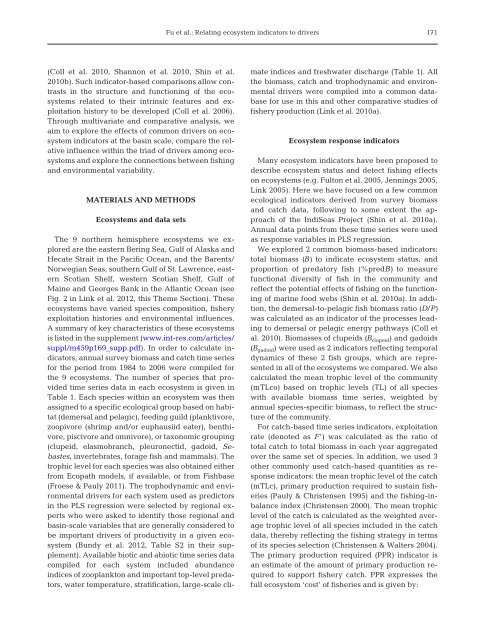Complete Theme Section in pdf format - Inter Research
Complete Theme Section in pdf format - Inter Research
Complete Theme Section in pdf format - Inter Research
Create successful ePaper yourself
Turn your PDF publications into a flip-book with our unique Google optimized e-Paper software.
Fu et al.: Relat<strong>in</strong>g ecosystem <strong>in</strong>dicators to drivers 171<br />
(Coll et al. 2010, Shannon et al. 2010, Sh<strong>in</strong> et al.<br />
2010b). Such <strong>in</strong>dicator-based comparisons allow contrasts<br />
<strong>in</strong> the structure and function<strong>in</strong>g of the ecosystems<br />
related to their <strong>in</strong>tr<strong>in</strong>sic features and ex -<br />
ploitation history to be developed (Coll et al. 2006).<br />
Through multivariate and comparative analysis, we<br />
aim to explore the effects of common drivers on ecosystem<br />
<strong>in</strong>dicators at the bas<strong>in</strong> scale, compare the relative<br />
<strong>in</strong>fluence with<strong>in</strong> the triad of drivers among ecosystems<br />
and explore the connections between fish<strong>in</strong>g<br />
and environmental variability.<br />
MATERIALS AND METHODS<br />
Ecosystems and data sets<br />
The 9 northern hemisphere ecosystems we ex -<br />
plored are the eastern Ber<strong>in</strong>g Sea, Gulf of Alaska and<br />
Hecate Strait <strong>in</strong> the Pacific Ocean, and the Barents/<br />
Norwegian Seas, southern Gulf of St. Lawrence, eastern<br />
Scotian Shelf, western Scotian Shelf, Gulf of<br />
Ma<strong>in</strong>e and Georges Bank <strong>in</strong> the Atlantic Ocean (see<br />
Fig. 2 <strong>in</strong> L<strong>in</strong>k et al. 2012, this <strong>Theme</strong> <strong>Section</strong>). These<br />
ecosystems have varied species composition, fishery<br />
exploitation histories and environmental <strong>in</strong>fluences.<br />
A summary of key characteristics of these ecosystems<br />
is listed <strong>in</strong> the supplement (www.<strong>in</strong>t-res. com/ articles/<br />
suppl/ m459 p169_supp.<strong>pdf</strong>). In order to calculate <strong>in</strong>dicators,<br />
annual survey biomass and catch time series<br />
for the period from 1984 to 2006 were compiled for<br />
the 9 ecosystems. The number of species that provided<br />
time series data <strong>in</strong> each ecosystem is given <strong>in</strong><br />
Table 1. Each species with<strong>in</strong> an ecosystem was then<br />
assigned to a specific ecological group based on habitat<br />
(demersal and pelagic), feed<strong>in</strong>g guild (planktivore,<br />
zoopivore (shrimp and/or euphausiid eater), benthivore,<br />
piscivore and omnivore), or taxonomic group<strong>in</strong>g<br />
(clupeid, elasmobranch, pleuronectid, gadoid, Sebastes,<br />
<strong>in</strong>vertebrates, forage fish and mammals). The<br />
trophic level for each species was also obta<strong>in</strong>ed either<br />
from Ecopath models, if available, or from Fishbase<br />
(Froese & Pauly 2011). The trophodynamic and environmental<br />
drivers for each system used as predictors<br />
<strong>in</strong> the PLS regression were selected by regional experts<br />
who were asked to identify those regional and<br />
bas<strong>in</strong>-scale variables that are generally considered to<br />
be important drivers of productivity <strong>in</strong> a given ecosystem<br />
(Bundy et al. 2012, Table S2 <strong>in</strong> their sup -<br />
plement). Available biotic and abiotic time series data<br />
compiled for each system <strong>in</strong>cluded abundance<br />
<strong>in</strong>dices of zooplankton and important top-level predators,<br />
water temperature, stratification, large-scale climate<br />
<strong>in</strong>dices and freshwater discharge (Table 1). All<br />
the biomass, catch and trophodynamic and environmental<br />
drivers were compiled <strong>in</strong>to a common database<br />
for use <strong>in</strong> this and other comparative studies of<br />
fishery production (L<strong>in</strong>k et al. 2010a).<br />
Ecosystem response <strong>in</strong>dicators<br />
Many ecosystem <strong>in</strong>dicators have been proposed to<br />
describe ecosystem status and detect fish<strong>in</strong>g effects<br />
on ecosystems (e.g. Fulton et al. 2005, Jenn<strong>in</strong>gs 2005,<br />
L<strong>in</strong>k 2005). Here we have focused on a few common<br />
ecological <strong>in</strong>dicators derived from survey biomass<br />
and catch data, follow<strong>in</strong>g to some extent the ap -<br />
proach of the IndiSeas Project (Sh<strong>in</strong> et al. 2010a).<br />
Annual data po<strong>in</strong>ts from these time series were used<br />
as response variables <strong>in</strong> PLS regression.<br />
We explored 2 common biomass-based <strong>in</strong>dicators:<br />
total biomass (B) to <strong>in</strong>dicate ecosystem status, and<br />
proportion of predatory fish (%predB) to measure<br />
functional diversity of fish <strong>in</strong> the community and<br />
reflect the potential effects of fish<strong>in</strong>g on the function<strong>in</strong>g<br />
of mar<strong>in</strong>e food webs (Sh<strong>in</strong> et al. 2010a). In addition,<br />
the demersal-to-pelagic fish biomass ratio (D/P)<br />
was calculated as an <strong>in</strong>dicator of the processes lead<strong>in</strong>g<br />
to demersal or pelagic energy pathways (Coll et<br />
al. 2010). Biomasses of clupeids (B clupeid ) and gadoids<br />
(B gadoid ) were used as 2 <strong>in</strong>dicators reflect<strong>in</strong>g temporal<br />
dynamics of these 2 fish groups, which are represented<br />
<strong>in</strong> all of the ecosystems we compared. We also<br />
calculated the mean trophic level of the community<br />
(mTLco) based on trophic levels (TL) of all species<br />
with available biomass time series, weighted by<br />
annual species-specific biomass, to reflect the structure<br />
of the community.<br />
For catch-based time series <strong>in</strong>dicators, exploitation<br />
rate (denoted as F’) was calculated as the ratio of<br />
total catch to total biomass <strong>in</strong> each year aggregated<br />
over the same set of species. In addition, we used 3<br />
other commonly used catch-based quantities as response<br />
<strong>in</strong>dicators: the mean trophic level of the catch<br />
(mTLc), primary production required to susta<strong>in</strong> fisheries<br />
(Pauly & Christensen 1995) and the fish<strong>in</strong>g-<strong>in</strong>balance<br />
<strong>in</strong>dex (Christensen 2000). The mean trophic<br />
level of the catch is calculated as the weighted average<br />
trophic level of all species <strong>in</strong>cluded <strong>in</strong> the catch<br />
data, thereby reflect<strong>in</strong>g the fish<strong>in</strong>g strategy <strong>in</strong> terms<br />
of its species selection (Christensen & Walters 2004).<br />
The primary production required (PPR) <strong>in</strong>dicator is<br />
an estimate of the amount of primary production required<br />
to support fishery catch. PPR expresses the<br />
full ecosystem ‘cost’ of fisheries and is given by:
















